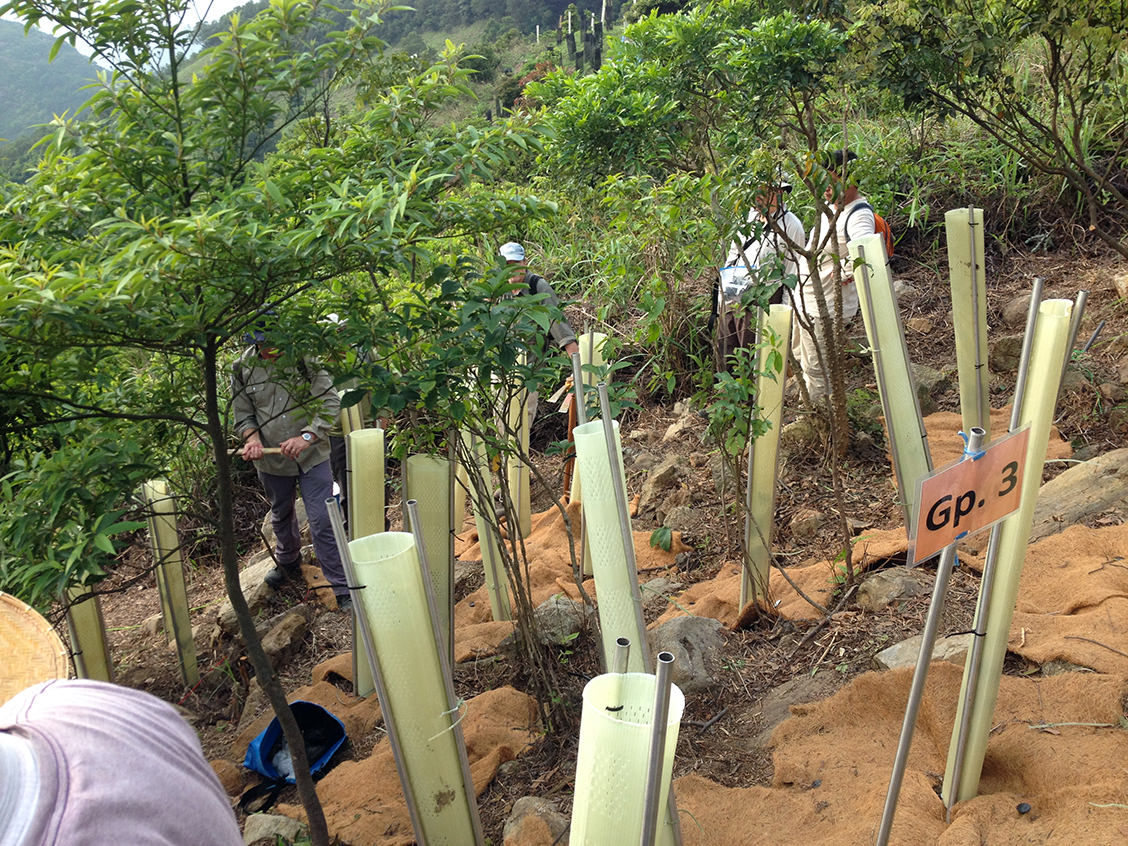
As part of our drive to better understand the factors that govern forest succession and constrain the restoration of ecosystem resilience, KFBG established a series of experimental forest restoration plots at the top of our site in 2013. Every year, KFBG organises a number of tree planting activities aimed at gradually converting these degraded grassy slopes into diverse native forest that can support a wide variety of wildlife.
Since the plots were set up, more than 60,000 tree seedlings representing more than 400 native species have been planted. All of these seedlings were raised in our nurseries from seeds collected in Hong Kong’s Country Parks. A seed collection number is assigned at the time of collection serves to permanently document the source of each tree. As far as possible, seeds of any one species are collected from multiple populations so as to maximise genetic diversity in the resulting forest.

In order to determine the best approach to planting trees for forest restoration, a number of different treatments have been trialled. Foremost amongst these has been the use of tree guards to protect the seedlings from herbivory, an intervention that has been found to greatly benefit seedling establishment and growth. To improve soil fertility, we trialled the use of different fertilisers and applied a mulch mixture containing compost and biochar. To suppress competition from surrounding grasses, we installed weeding mats made of coconut fibre. Over several consecutive years, we applied different combinations of these experimental treatments (tree guards, fertilisers, mulches and weeding mats) to an array of different tree species. The results of this study were published in early 2025 in an peer reviewed academic journal (see KFBG’s research reveals that different native tree species respond differently to a range of different restoration methods and environmental factors ).
In many forest restoration efforts worldwide, only the trees are considered; the shrubs, palms, vines, epiphytes and herbs are simply overlooked, even though they contribute significantly to species diversity and ecosystem functioning. We view a healthy understorey as a vital component of diverse restored forest and are therefore being careful not to neglect these important plants. To this end, four 20 ⨯ 20 m subplots have been selected for enrichment planting to test if a rich understorey can be artificially restored.
In primary forest, the array of species present and their relative abundance varies from habitat to habitat. Since an express aim of our forest restoration programme is to recreate an ecosystem that, as far as possible, approximates to natural forest, species composition and relative abundance are important considerations. However, because mortality during establishment cannot be predicted, individual species must inevitably be planted at higher densities than they would naturally be found in mature old growth. Because of this, stems of over-represented species need to be thinned once they reach a certain size. Thinning is normally undertaken when the canopy begins to close or if one or a few particular species start to gain undesirable dominance due to precocious reproduction. In addition, individual trees with misshapen stems or crowns will be removed or pruned based on our arborists’ experience.

Although this work is very much rooted in a desire to see natural forest flourish in Hong Kong once more, there is also a strong research component. We measure the height, basal diameter and crown size and assess the performance of each seedling 1, 2 and 5 years after planting. Each tree’s x and y coordinates within the plots are also recorded to generate accurate maps of forest structure. Our researchers mine the data to exploring the relative importance of a range of factors that could be influencing the performance of individual seedlings and the growth of the forest as a whole.
Ultimately, we hope to derive a set of tried and tested silvicultural methods for nurturing mixed native forest of regional, perhaps even global, relevance. By combining observations of remnant primary forests in the region, experimentation and adaptive planting, we hope to understand and remove the barriers to successful tropical forest restoration.
Further reading
- Zhang, J., Cardoso, F. C. G., Zhu, H., Cheuk, M. L., Fischer, G. A., & Gale, S. W. (2025). Temporal Shifts in the Importance of Environmental Factors and Management Interventions Among Species in the Early Stages of Forest Restoration. Journal of Forestry Research. doi: https://doi.org/10.1007/s11676-025-01857-4
